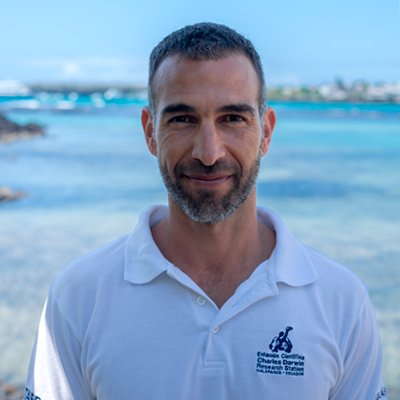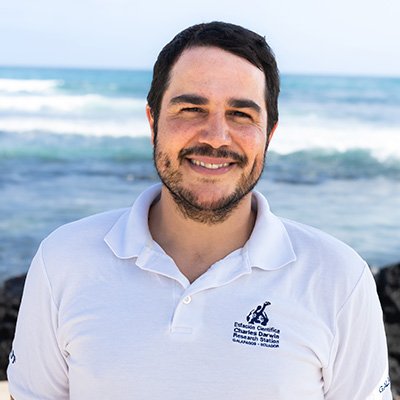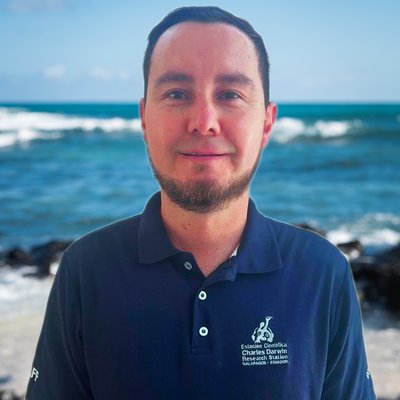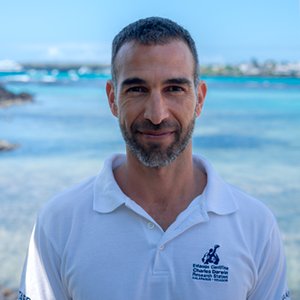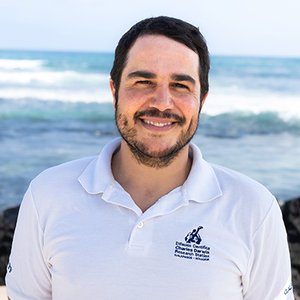Sharks have thrived on our planet for over 400 million years. Yet overfishing has drastically reduced global shark populations, with many species now threatened with extinction. Our scientific work seeks to inform conservation measures, so sharks are better protected in Galapagos and the Eastern Tropical Pacific.
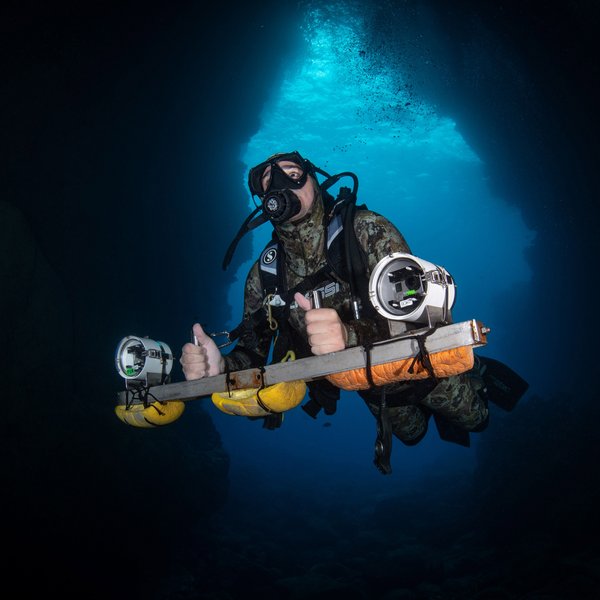
Our team
Gabriel Vianna
Principal Investigator - Shark Ecology & Conservation
Pelayo Salinas de León
Co-Principal Investigator - Shark Ecology & Conservation
Simon McKinley
Junior Spatial Ecologist
Andrés Romero
Fisheries Scientist - Analytics
Edwin Castro
Fisheries Scientist - Governance
Katherine Rezabala
Research Assistant
Mikel Goñi
Field Research Assistant
Erika de la Cruz
Research Assistant
Other collaborators
Jennifer Suarez Moncada, Galapagos National Park Directorate, Ecuador
Prof. Mahmood Shivji, Save Our Seas Shark Research Center and Guy Harvey Research Institute, USA
Dr. Jeremy Vaudo, Save Our Seas Shark Research Center and Guy Harvey Research Institute, USA
Prof. Diego Páez-Rosas, Universidad San Francisco de Quito, Ecuador
Dr. Tyler D Eddy, Memorial University of Newfoundland, Canada
Denisse Fierro-Arcos, University of Tasmania, Australia
Dr. Florencia Cerutti Pereyra, IFREMER, France
Dr Etienne Rastoin, Curtin University, Australia
Collaborating institutions
WWF Ecuador
Save Our Seas Shark Research Center
Guy Harvey Research Institute
Donors
Save Our Seas Foundation, Darwin and Wolf Conservation Fund, Mark and Rachel Rohr Foundation, Guy Harvey Research Institute, Focused on Nature, COmON Foundation
The challenge
It is estimated that more than a third of all shark and ray species are threatened with extinction. Overfishing is the main cause behind these dramatic population declines, with an estimated 100 million sharks fished every year around the world. Around 75% of oceanic shark species are at risk of extinction today.
Since 1998, sharks have been protected from industrial fishing in Ecuador by the Galapagos Marine Reserve (GMR), and more recently in 2022 by the Hermandad Marine Reserve. However, many shark species are migratory and swim thousands of kilometers, often across unprotected waters, to mate, feed, and nurse. In these waters, they are vulnerable to fishing, which is often illegal, unregulated, and unreported. It is therefore critical that we understand how to better protect these iconic species beyond the marine reserves, and across their migratory region.
Understanding how to improve shark conservation is crucial to give these animals a future in a rapidly changing planet. Join us on a journey of scientific discovery and exploration to save sharks and preserve marine life diversity!
What we do
The islands of Darwin and Wolf, to the north of the archipelago, aggregates one of the largest shark biomasses on Earth, providing a unique opportunity for researchers to study sharks. Here our shark researchers work to conserve many of the species found inside the Galapagos and Hermandad Marine Reserves. They do so by monitoring the number of sharks over time, evaluating the status of their populations, and studying their movement patterns and the levels of connectivity among populations at a regional level.
Our research focuses on vulnerable, endangered, and critically endangered species, such as scalloped hammerhead sharks, Galapagos sharks, tiger sharks, blacktip sharks, silky sharks, blue sharks, among others.
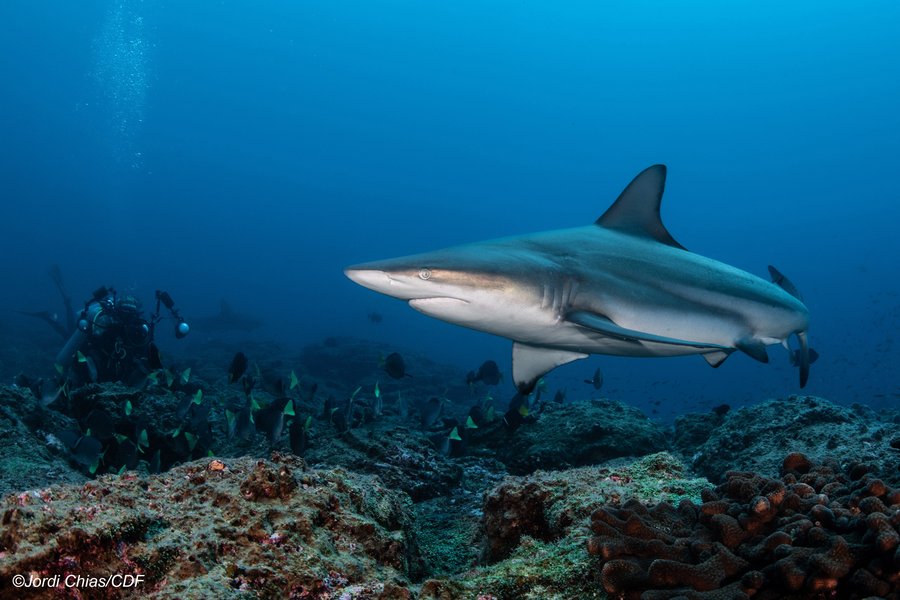
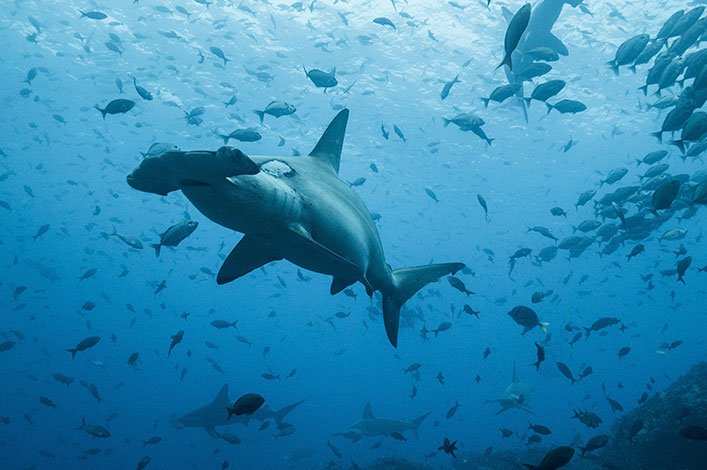
Why it matters
Sharks are essential to the health and balance of marine ecosystems. They help to maintain the health of reefs, seamounts, mangroves, shores, and promote the stability of these fragile ecosystems. Many species also play a vital role as apex predators, helping to control populations of other species and maintain biodiversity.
By gaining a better understanding of the movement patterns, habitat use, and population dynamics of sharks in Galapagos and the surrounding waters, we are providing information for more effective conservation measures that protect shark populations in Galapagos, the Eastern Tropical Pacific (ETP), and beyond. Furthermore, the data generated over the years by the project are essential to help in our understanding of the growing effects of climate change on shark populations.
In Galapagos, sharks are also of great importance to the local economy, given that the marine tourism industry, which heavily relies on shark sightings, provides employment to 37% of the active local workforce. Some estimates determine that on average a live shark in Galapagos is worth $360,000 per year, while one fished for its fins in another part of the world generates no more than $200.
Specific program objectives
- Evaluate the effectiveness of the GMR in protecting sharks and predatory fish, and assess the impact of El Niño cycles on their populations.
- Monitor the abundance of coastal and oceanic shark populations in the GMR and surrounding waters. Investigate variations in the composition of shark communities inhabiting the ETP region.
- Conduct long-term monitoring of tiger shark movements to understand their use of the GMR.
- Identify and characterize the migratory and connectivity patterns of oceanic, tiger, and hammerhead sharks within the GMR and across the wider ETP region.
- Assess the socio-economic value of sharks as a tourism resource in the GMR.
- Provide information about the status of shark populations to the Galapagos National Park Directorate to contribute to the development of conservation strategies to protect the diversity and health of shark communities.
- Provide information about the status of shark populations to government authorities in order to contribute to the development of improved management plans within Ecuadorian waters and the ETP.
- Raise awareness about the importance of sharks in marine ecosystems through educational campaigns directed at the local community, particularly children and youth.
Our impact
Satellite tracking of pregnant females of the critically endangered scalloped hammerhead shark has shown that they migrate from the Galapagos Islands to coastal areas of Central and South America to give birth, exposing them to heightened risks of fishing on their journeys. This finding highlights the importance of regional fisheries management of shark populations.
Stable isotope studies conducted by our researchers suggest that hammerhead sharks in the GMR respond to climate fluctuations, potentially benefiting from an improved diet during La Niña events, as the overall marine productivity in the region increases during these events. This finding highlights the vulnerability of shark populations to climate change.
Blue sharks are truly oceanic wanderers, they are also one of the most heavily-fished shark species globally, and among the top three most captured sharks in Ecuadorian waters. In 2023, we started a blue shark tagging program to learn more about their movement patterns in the region. This information will be key to identifying areas of overlap with the numerous artisanal and industrial fishing fleets that operate in the ETP region, and inform management actions aimed at reversing ongoing population declines.
Silky sharks are also one of the most heavily-fished shark species in the world. Our researchers have analyzed data from more than 70 silky sharks tagged with satellite transmitters since 2021. Many sharks were tracked for more than a year, and some for up to two years. In fact, many of these sharks are still being tracked. This research has yielded the longest track of a silky shark to date, with one female shark traveling over 33,000 km in 1.5 years half-way to Hawaii and back again, twice. Indeed, many of the tagged sharks spent large periods of time outside of marine protected areas, and at least three have been caught and killed by fishing vessels. These findings highlight the need for ambitious and comprehensive regional management strategies to improve fisheries management and reduce ongoing silky shark population declines across the ETP region.
Our satellite tagging research has revealed that tiger sharks stay inside the GMR for long periods of time, with some individuals spending over 90% of their time within the reserve. This suggests that the GMR provides essential habitat for tiger sharks. Studies have also revealed the ecological importance of green sea turtles in the diet of tiger sharks in the GMR.
Why you should support us
Fishing and climate change are putting unprecedented pressures on shark populations in the ETP region, and impacting the populations in Galapagos. As a result, long-term conservation of shark communities will only be possible if science-based management and mitigation strategies are developed and implemented effectively. By supporting our program, you are helping to protect sharks and ensure the long-term health of marine ecosystems.
Here are some specific reasons why you should support our program:
- To help protect sharks, which are major players to the health and balance of marine ecosystems.
- To support the development and implementation of science-based shark conservation strategies.
- To support the development of expanded marine protected areas in the region.
- To help ensure that shark populations in Galapagos and the region are conserved, and can be appreciated by future generations.
Bibliography
Rastoin-Laplane, E., Salinas-de-León, P., Goetze, J.S., Saunders, B.J., McKinley, S.J., Norris, C., Gosby, C., Mattingly, A., Garcia, R. and Harvey, E.S., 2023. Fluctuations of Galapagos mid-water and benthic reef fish populations during the 2015–16 ENSO. Estuarine, Coastal and Shelf Science, 294, p.108523. https://doi.org/10.1016/j.ecss.2023.108523
Simpfendorfer, C.A. et al. 2023. Widespread diversity deficits of coral reef sharks and rays. Science, 380(6650), pp.1155-1160. https://doi.org/10.1126/science.ade4884
Mossbrucker, M.E., Acuña-Marrero, D., Cundy, M.E., Fierro-Arcos, D., Suárez-Moncada, J.M., Rastoin-Laplaine, E. and Salinas-de-León, P., 2023. First records of two rays and three bony fishes for the Galapagos Islands. Journal of the Marine Biological Association of the United Kingdom, 103, p.e28. https://doi.org/10.1017/S0025315423000176
Moya-Serrano, A.V. and Salinas-de-León, P., 2022. Chafing behavior by scalloped hammerhead sharks (Sphyrna lewini), including an unusual scratching of claspers. Marine Biodiversity, 52(6), p.66. https://doi.org/10.1007/s12526-022-01311-2
Harned, S.P., Bernard, A.M., Salinas‐de‐León, P., Mehlrose, M.R., Suarez, J., Robles, Y., Bessudo, S., Ladino, F., López Garo, A., Zanella, I. and Feldheim, K.A., 2022. Genetic population dynamics of the critically endangered scalloped hammerhead shark (Sphyrna lewini) in the Eastern Tropical Pacific. Ecology and Evolution, 12(12), p.e9642. https://doi.org/10.1002/ece3.9642
Cerutti-Pereyra, F., Salinas-De-León, P., Arnés-Urgellés, C., Suarez-Moncada, J., Espinoza, E., Vaca, L. and Páez-Rosas, D., 2022. Using stable isotopes analysis to understand ontogenetic trophic variations of the scalloped hammerhead shark at the Galapagos Marine Reserve. Plos one, 17(6), p.e0268736. https://doi.org/10.1371/journal.pone.0268736
Arnés-Urgellés, C., Salinas-de-León, P., Rastoin-Laplane, E., Vaca-Pita, L., Suárez-Moncada, J. and Páez-Rosas, D., 2021. The effects of climatic variability on the feeding ecology of the scalloped hammerhead shark (Sphyrna lewini) in the tropical eastern pacific. Frontiers in Marine Science, 8, p.625748. https://doi.org/10.3389/fmars.2021.625748
Páez-Rosas, D., Suarez-Moncada, J., Elorriaga-Verplancken, F.R., Proaño, A., Arnés-Urgellés, C., Salinas-de-León, P. and Galván-Magaña, F., 2021. Trophic variation during the early stages of blacktip sharks (Carcharhinus limbatus) within coastal nurseries of the Galapagos Marine Reserve. Journal of Sea Research, 170, p.102023. https://doi.org/10.1016/j.seares.2021.102023
Salinas-de-León, P., Andrade, S., Arnés-Urgellés, C., Bermudez, J.R., Bucaram, S., Buglass, S., Cerutti, F., Cheung, W., De la Hoz, C., Hickey, V. and Jíménez-Uzcátegui, G., 2020. Evolution of the Galapagos in the Anthropocene. Nature Climate Change, 10(5), pp.380-382. https://doi.org/10.1038/s41558-020-0761-9
Arnés-Urgellés, C., Páez-Rosas, D., Barahona, D. and Salinas-De-León, P., 2020. First Direct Evidence of a Galapagos Sea Lion. Aquatic Mammals, 46(3), pp.254-258. https://doi.org/10.1578/AM.46.3.2020.254
Cerutti-Pereyra, F., Moity, N., Dureuil, M., Ramírez-González, J., Reyes, H., Budd, K., Jarrín, J.M. and Salinas-de-León, P., 2020. Artisanal longline fishing the Galapagos Islands–effects on vulnerable megafauna in a UNESCO World Heritage site. Ocean & Coastal Management, 183, p.104995. https://doi.org/10.1016/j.ocecoaman.2019.104995
Salinas-de-León, P., Fierro-Arcos, D., Suarez-Moncada, J., Proaño, A., Guachisaca-Salinas, J., & Páez-Rosas, D. (2019). A matter of taste: Spatial and ontogenetic variations on the trophic ecology of the tiger shark at the Galapagos Marine Reserve. PLOS ONE, 14(9), e0222754. https://doi.org/10.1371/journal.pone.0222754
Salinas-de-León, P., Phillips, B., Ebert, D., Shivji, M. S., Cerutti-Pereyra, F., Ruck, C., … Marsh, L. (2018). Deep-sea hydrothermal vents as natural egg-case incubators at the Galapagos Rift. Scientific Reports, 8(1), 1788. https://doi.org/10.1038/s41598-018-20046-4
Cerutti-Pereyra, F., Yánez, A.B., Ebert, D.A., Arnés-Urgellés, C. & Salinas-de-León, P. (2018). New record and range extension of the Deepsea Skate, Bathyraja abyssicola (Chondrichthyes: Arhynchobatidae), in the Galapagos Islands. Journal of the Ocean Science Foundation, 30, pp.85-89. http://dx.doi.org/10.5281/zenodo.1400829
Arnés-Urgellés, C., Hoyos-Padilla, E.M., Pochet, F. & Salinas-de-León, P. (2018). First observation on the mating behaviour of the marbled ray, Taeniurops meyeni, in the Tropical Eastern Pacific. Environmental Biology of Fishes, 101(12), pp.1693-1699. https://doi.org/10.1007/s10641-018-0818-z
Acuña-Marrero, D., Cruz-Modino, R. de la, Smith, A. N. H., Salinas-de-León, P., Pawley, M. D. M., & Anderson, M. J. (2018). Understanding human attitudes towards sharks to promote sustainable coexistence. Marine Policy, 91(May 2017), 122–128. https://doi.org/10.1016/j.marpol.2018.02.018
Acuña-Marrero, D., Smith, A. N. H., Salinas-de-León, P., Harvey, E. S., Pawley, M. D. M., & Anderson, M. J. (2018). Spatial patterns of distribution and relative abundance of coastal shark species in the Galapagos Marine Reserve. Marine Ecology Progress Series, 593, 73–95. https://doi.org/10.3354/meps12505
Salinas-de-León, P., Hoyos-Padilla, E. M., & Pochet, F. (2017). First observation on the mating behaviour of the endangered scalloped hammerhead shark Sphyrna lewini in the Tropical Eastern Pacific. Environmental Biology of Fishes, 100(12), 1603–1608. https://doi.org/10.1007/s10641-017-0668-0
Pazmiño, D. A., Maes, G. E., Simpfendorfer, C. A., Salinas-de-León, P., & Van Herwerden, L. (2017). Genome-wide SNPs reveal low effective population size within confined management units of the highly vagile Galapagos shark (Carcharhinus galapagensis). Conservation Genetics, 18(5), 1151–1163. https://doi.org/10.1007/s10592-017-0967-1
Acuña-Marrero, D., Smith, A. N. H., Hammerschlag, N., Hearn, A. R., Anderson, M. J., Calich, H., … Salinas-de-León, P. (2017). Residency and movement patterns of an apex predatory shark (Galeocerdo cuvier) at the Galapagos Marine Reserve. PloS One, 12(8), e0183669. https://doi.org/10.1371/journal.pone.0183669
Salinas de León, P., Acuña-Marrero, D., Rastoin, E., Friedlander, A. M., Donovan, M. K., & Sala, E. (2016). Largest global shark biomass found in the northern Galápagos Islands of Darwin and Wolf. PeerJ, 4, e1911. https://doi.org/10.7717/peerj.1911
Acuña-Marrero, D., Jiménez, J., Smith, F., Doherty Jr., P. F., Hearn, A. R., Green, J. R., … Salinas-de-León, P. (2014). Whale Shark (Rhincodon typus) Seasonal Presence, Residence Time and Habitat Use at Darwin Island, Galapagos Marine Reserve. PloS One, 9(12), e115946. https://doi.org/10.1371/journal.pone.0115946
Acuña-Marrero, D., Zimmerhackel, J.S., Mayorga, J. and Hearn, A. (2013). First record of three shark species, Odontaspis ferox, Mustelus albipinnis and Centrophorus squamosus, from the Galápagos Islands. Marine Biodiversity Records, 6. https://doi.org/10.1017/S1755267213000596
Habla Tiburón: conserving sharks and rays in Ecuador
Ecuador has played a leading role in ocean conservation in recent years. Currently, 13% of the Ecuadorian exclusive economic zone is under some sort of management, and the government has pledged to protect 30% by 2030. However, illegal fishing remains a key issue for shark conservation today.
Since June 2023, our sustainable fisheries and shark researchers have been working on an ambitious five year project to strengthen seascape governance in order to safeguard shark and ray populations in mainland and insular Ecuador.
Concretely, the project aims to:
- Strengthen fisheries governance through a participatory model.
- Increase monitoring, control, compliance and traceability capacities of national authorities and fisher associations to combat illegal, unreported and unregulated fishing.
- Promote responsible fishing practices by implementing market and conservation incentives.

Latest news
-
10 Oct 24 /Healthy Populations of Sharks and Rays, Thriving Communities: The Habla Tiburón Approach
Habla Tiburón is a project that aims to improve the long-term health of shark and ray populations in Ecuadorian waters while empowering fishing communities.
-
17 Jul 23 /
-
27 Jun 23 /CDF and WWF launch project to promote the conservation of sharks and rays in Ecuador
CDF and WWF launch project "Habla Tiburón" to promote the conservation of sharks and rays and empower fishing communities in Ecuador

Protect Galapagos, Impact the World
The impact you make on this small ecosystem of enormous biodiversity is part of a larger footprint you are leaving for the world's future. Join us on our mission to safeguard one of our planet’s most important natural treasures through science and conservation action by making a donation today. Thank you for making an impact with us.





